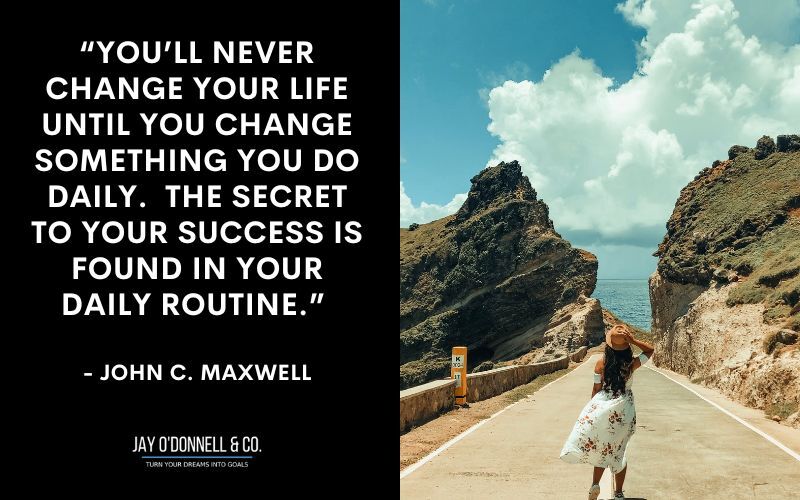- 609-310-1633
- contact@odonnellgrp.com
How to write a goal statement.
This is a fantastic question.
A goal statement is a verbal or written statement that comprises all the relevant data you need to set goals for your future.
Learning how to write a goal statement is an essential skill that’ll give you a better understanding of your goals and how you can effectively achieve them.
And you’re about to learn exactly how to create one.
In this post, you’ll learn how to write a goal statement using 6 easy steps. This statement will help you crush your goals and succeed in your dreams.
What Is Included In A Goal Statement?

In order to effectively create a goal statement, you need to include 6 basic foundational elements.
These elements include:
- The specifics of the goal
- A method for measuring the goal
- Assurance that the goal is achievable
- A statement of relevance for longer-term goals
- A time deadline
- A reason for why you want to achieve the goal to begin with
In other words, you want your goal statement to contain all the elements that also make it a SMART goal.
How you creatively arrange the elements of your goal statement is entirely up to you.
However, you must ensure that your SMART goal statement contains these elements.
By creating a thorough and complete goal statement, you’ll have taken the first step in dreaming big dreams, turning those dreams into goals, writing down those goals, and creating a roadmap to success.
Now that you know what a goal statement entails, it’s time to talk about each element of the statement.
What Is An Example Of A Goal Statement?

For this section, we will use an example goal statement.
You don’t necessarily have to follow this pattern to the letter.
You should write yours in a manner that makes the most sense to you.
However, for a better understanding of goal statements, we’re going to take this specific goal statement, break it down, and examine how it fulfills all 6 points of the criteria for how to write a goal statement using the SMART goal system.
Here’s our example:
“I will achieve my goal of having a fit, athletic, attractive, healthy body by losing 8 pounds over the course of the next 3 months. I’ll achieve this by walking every day for 1 hour and maintaining my current diet/caloric intake. I’ll measure my results by weighing myself every morning. This will contribute to my long-term goal of looking and feeling my best as I get older. I want to accomplish this goal because I want to continue to maintain good health into my 40s and beyond.”
How Do You Write A SMART Goal Statement – In 6 Easy Steps

1. Make It Specific
As you can see, the first sentence in the example sets the tone for a specific overall goal structure.
“I will achieve my goal of having a fit, athletic, attractive, healthy body by losing 8 pounds over the course of the next 3 months.”
This is perfect because you want to be as specific as possible whenever you write down your goals.
This will help to give you better guidance, and help to eliminate the vagueness that can sometimes hinder us on our path to success.
2. Make It Measurable
As you probably noted, the third sentence in our goal statement example explicitly explains how the goal will be measured.
“I’ll measure my results by weighing myself every morning.”
This is exactly what you want. Whenever you set a goal for yourself, you always want to make sure that the goal is somehow measurable.
If you can’t measure a goal, you’ll need to go back to the drawing board and rework it so that you have some kind of measurable metric you can use to track your progress.
3. Make It Achievable
When we look at the example and the amount of effort required to see the goal through to completion, we see that it’ll require exactly one hour of walking per day, along with daily caloric restrictions.
Now, this may or may not be applicable in your case, depending on your specific life and situation.
But, this is really what you want to look at.
You want to ensure that the level of effort required to succeed at the goal will be sustainable and achievable in the long run.
If the goal calls for levels of effort that simply aren’t achievable or sustainable for you, then you’ll need to go back to the drawing board and rework the goal to ensure that it’s actually doable.
You always want to make your goals ambitious.
However, you want to balance this with ensuring you can attain them.
This sets you up for success right from the beginning.
4. Make It Relevant
The following sentence from our example explains why this goal statement is relevant to the larger context and other long-term goals.
“This will contribute to my long-term goal of looking and feeling my best as I get older.”
This is important because if the goal isn’t relevant to the future you desire for yourself, then you’re highly unlikely to stay motivated long enough to see it through.
So, make sure that whenever you set goals, you set goals that are relevant and that will empower you to succeed at the things that matter.
5. Make It Time-Bound
Every good goal will include a deadline for goal completion, and this deadline should be achievable—while also being a little bit challenging and ambitious.
According to the example statement, this goal is to be achieved within a three-month time period.
This is a perfect duration. Quarterly goals are generally considered medium-term goals, meaning that they’re not too short and not too long.
Every good goal should be time-bound to give you a particular and defined deadline.
6. Define Your ‘Why’
Whenever you set a goal, you always want to pair it with a ‘why’ statement that demonstrates the purpose, intent, and passion behind the goal.
Why is this goal important to you?
Why pursue this goal and not a different goal?
As read in the final sentence of the example goal statement:
“I want to accomplish this goal because I want to continue to maintain good health into my 40s and beyond.”
This is excellent because you always want your goals to be personal, engage your purpose, and create a future vision for your life.
Writing down your ‘why statement’ empowers you to stay motivated and stick with the goal for the right reasons.
Conclusion
Hopefully, this post has given you some useful information that’ll help you with understanding not only how to write a goal statement, but also how this practice can help you in your goal-setting and life-success journey.
Of course, at the end of the day, this is just another part of the larger, overarching process of turning your dreams into goals, and writing those goals down to create a roadmap for success in your life.
This is how you begin your journey to success and crush it.
Need some help? Download my weekly goal-setting sheet, print out a few, and give it a try.
You can also sign up for my email list to get a free copy of my Goal Setting Essentials Starter Kit.
You’ve got this. I believe in you.
Now it’s time to get to work.
Best wishes…
Jay O’Donnell
Quick Links
© 2024 All Rights Reserved.
